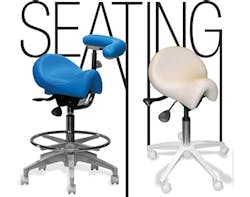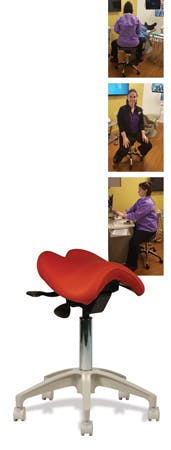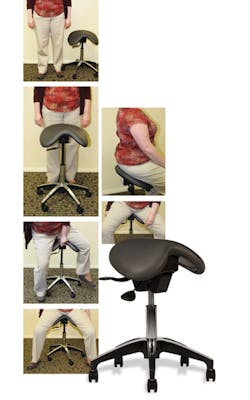Take a stand on seating: Strategies defuse occupational hazards associated with sedentary positions
Strategies defuse occupational hazards, including risks associated with sedentary positions
By Anne Guignon, RDH, MPH, CSP
The dental stools from the early 1970s were no more than marshmallows on sticks. Stools were stools, no matter your size, shape, height, weight, torso, or leg length. The whole conversation about safe, ergonomic seating had not begun, and that is when the real problems began. Most clinicians still sit on whatever stool the office provides. Traditional stools require the user to sit with thighs parallel to the floor, a position that flattens the healthy curve in the lumbar spine.
So what is the solution? Standing upright puts the body in a neutral position. Standing creates the strongest, most stable position for the musculoskeletal system: the spine, bones, disks, muscles, ligaments, and tendons.
But it is virtually impossible to provide clinical dental care while standing or sitting in a fully upright position. Dental health-care workers move forward into the patient space to provide care. Neutral postures in the dental world always involve a certain measure of flexing the trunk or moving the neck forward. The key is to minimize flexing as much as possible.
Over the past decade, sit/stand positioning has become increasingly popular in the workplace. While most studies involving sit/stand positioning involve the use of an active workstation or a sit/stand desk, much can be learned about the effects of this type of positioning on worker health. Several recent studies have found sit/stand positioning decreased traditional sitting time, reduced muscle inactivity, increased energy expenditure, and reduced sedentary behaviors.1-3 Workers using sit/stand positioning reported less fatigue and low-back pain, an increase in perceived neck and shoulder comfort,5 improved blood flow,6 and a reduction in harmful lumbar flexion.7 There were no negative effects on work ability or productivity.6,7
In 2011, the Centers for Disease Control and Prevention released a report on the Take-a-Stand Project. Fifty-four percent of the study subjects who used a sit/stand workstation for four weeks reported a reduction in neck and upper-back pain, a benefit that disappeared when the workers returned to traditional seating. The advantages of sit/stand positioning in the dental office are numerous and include sitting up higher, a more erect spinal posture, deeper breathing, more stable reach, improved leg circulation, balanced pelvic position, and actively engaging core muscles.
Two different seating options create sit/stand positioning: a stability ball and a saddle stool. While both help tremendously with improving spinal posture, there are significant differences between the two options. Finding the right seating option is based on the Goldilocks principle.
Ball seating-Stability balls have been used in physical therapy and exercise worlds for many years but were never intended to be seating devices. Ball seating started showing up in the workplace when users determined balls allowed the user to sit up straighter and maintain a safe lumbar curve in the spine. It is important to select a ball that fits the user's height, weight, and leg length.
A ball should be inflated to the point where the user has a seating area that maintains a stable lumbar curve with the feet flat on the floor. A support cradle with casters makes it easy to roll a ball across the floor, and risers can be added to the cradle to increase the overall height of a ball stool.
Balls are a reasonable seating strategy when the workspace height is fixed, such as working at a desk, but it is not the best option for the clinical setting for several reasons. Balls are much larger than a saddle, so they are not ideal in treatment rooms that have limited space. Most saddles do not have much seat pan bulk at the front, so the operator can sit closer to the patient in a saddle than a ball. But most importantly, there is just not enough time during the day to inflate or deflate a saddle between patients. This lack of adjustability means clinicians must adjust their postures to accommodate varying patient sizes, thereby diminishing the perceived ergonomic benefit if used in the treatment room.
Kristin Good, RDH, is a hard-working dental hygienist with a heart of gold and a passion for workplace safety and wellness. Kristin spends her days in a very unique clinic treating the underserved.
When Kristin was in dental hygiene school, she heard the ergonomic message loud and clear. From that point on, she has focused on protecting her career. She purchased three raffle tickets, and she was the lucky recipient of a Crown Seating saddle stool during a continuing education course in March.
Figure 1: A balance tripod position creates a healthy lumbar curve and keeps arms in a relaxed, neutral position. (top)
Figure 2: Kristin demonstrates perfect balance on a saddle stool. (middle)
Figure 3: Saddle seating in a nonclinical application. (bottom)
Saddle seating-A 2013 study conducted by Annetts and colleagues measured pelvic tilt, lumbar angle, neck angle, and head tilt using four different seating options, including a saddle and traditional office chair. The saddle produced the best lumbar/pelvic, cervical, and overall postures of the four seating options.8 A 2007 study, comparing a Western-style saddle to a standard office chair, concluded the saddle reduced lower-back discomfort more effectively and created a more open thigh-to-trunk angle, a position associated with optimal seating postures.9
A saddle stool can be an excellent ergonomic tool that provides a healthy seating posture as we perform intricate, demanding dental procedures. In 2007, Gandavadi and colleagues assessed dental student postures using traditional seating and a Western saddle stool. Students using saddle seating had statistically significant lower rapid upper limb assessment (RULA) scores than those using traditional seating, and they were able to maintain acceptable working postures.10
When saddle stools were first introduced, the choices were limited. It quickly became apparent that the size and shape of the seat pan are the most important features to consider. The first saddle stools were based on a Western saddle design, which features a large, tall hump in the middle. Western saddles work well for people with a narrow pelvis and tight hip muscles. This style keeps the legs much closer together. A modified English saddle looks somewhat like a warped Frisbee, and has a very mild rise in the middle. Several companies offer a split English saddle that can be adjusted to fit an individual's pelvic anatomy. By design, English saddle users sit in a tripod position with their legs spread farther apart than in Western saddles.
One company makes a hybrid saddle, called the Denver, which combines features from both the Western and modified English design. There are also stools made with a triangular seat pan that can be adjusted to create a sit/stand position. Dynamic saddles are built with a complex scissorlike adjustment system that allows a small backrest to move as the seat pan moves. While it may seem counterintuitive, most clinicians do not use a saddle stool with a back because sit/stand positioning keeps the spine in a neutral position by preserving a healthy lumbar curve. A properly fitted saddle allows clinicians to keep their arms positioned at their sides, so most find arm supports unnecessary.
Actual seat pan size and slope varies between manufacturers. Look for a rounded waterfall seat pan edge that does not impinge on the circulation in the back of the leg. Currently, the majority of saddle users are women, but saddle designs are not gender-based. Many men have successfully adopted saddle seating.
The key to success is finding the right seat design and adjusting the device to fit the user. Purchasing the least expensive or most touted saddle from an online source without testing the product is risky. The wrong saddle design, or one that is not properly adjusted to the user's torso, can add to or create musculoskeletal problems.
Understanding seating components
Saddles specifically designed for dental offices are manufactured to provide a comfortable seating experience for years, while standing up to health-care environment protocols. Seating components that contribute to the overall comfort and durability include seat substructure, upholstery, padding, seat tilt mechanism, hydraulic cylinder, base, and casters. Seat pan substructures can be made out of inexpensive plywood. Injection-molded seats are a more expensive but more durable option. Injection-molded seats weigh much less than wood, making it easier to transport these saddles from location to location.
Saddles manufactured for a business office or beauty salon are typically made from less dense foam and with cloth or vinyl upholstery, fabrics not designed to withstand frequent disinfection. Innovative, medical-grade upholstery materials are durable and easy to clean. One product contains silver ions, a natural antimicrobial. Lightly textured fabrics are more appropriate than smooth, slick fabrics. Texture improves grip. This helps the user balance evenly as the stool moves around the treatment room. Padding options range from sophisticated, durable combinations of memory and gel foam to inexpensive, low-density foam padding.
A five-caster base is more stable than a four-caster stool. Select casters that correspond to the surface where the saddle will be used: hard floor or carpet. Cylinder height should be based on user leg length, not height. Clinicians with an inseam length no longer than 30" can use a standard (medium) cylinder. Tall cylinders are appropriate for those with longer legs and, in rare cases, shorter cylinders are needed for those who need to go lower to the ground. An adjustable seat-tilt mechanism to create a custom seat pan pitch can keep the spine in neutral.
Getting saddle positioning right
Saddles are an important ergonomic tool, designed to help create a neutral body posture for the user. They are not complicated, but there are a few steps that make the transition from traditional chairs to a saddle much smoother.
• Make sure to sit behind the front edge of the saddle.
• Balance your weight evenly across the saddle width.
• Straddle the seat and create a tripod with your knees wider than your hips with feet flat on the ground.11 The wider the saddle, the wider the tripod (figure 1).
• Pick up both feet at the same time to determine if the seat pan tilt angle is correct (figure 2). If your spine is in neutral, your torso will feel perfectly balanced on the seat. If not, readjust the tilt.
Ergonomic specialist, Cindy Purdy, RDH, CEAS, has observed that initially many people tend to tilt the seat pan too far forward or sit too close to the front rim, which results in an uncomfortable "first ride" experience. A detailed video about saddle seating adjustments can be found at this internet site: youtube.com/watch?v=oEDDgAP3Ctk&feature=youtu.be.
• Before working on a patient, adjust the stool height first, and fine-tune the patient chair position next.
• Sit with your torso facing the patient chair. Think belly button to the patient chair. Using any kind of saddle changes the geometry of how the user sits in relationship to the patient's oral cavity. Since saddles position a clinician higher and closer to the patient, your current magnification system may need a minor adjustment to the working distance and/or declination angle.
Adjustment matters
See the related sidebar for tips about sitting on a saddle. Just as with any new device, there is a learning curve when transitioning from a traditional seat to a saddle. It's common to have a bit of "saddle" soreness in the first week. Sit/stand seating uses different muscles. Alternate seating options during the first week or two, gradually increasing saddle time until your body is fully acclimated. Classic symptoms of improper seat pan tilt include sliding off the seat, pelvic pressure, pressure on the inner thigh, and skin irritation. Incorrect height adjustment can lead to skin irritation or thigh pressure. A user who finds a cushioned seat uncomfortable should opt for less dense padding. Hip discomfort is an indication that the saddle is either too wide or too narrow for the user.
While sit/stand positioning has helped many have a more comfortable day, it is not intended to reverse a preexisting condition such as scoliosis, arthritis, a neuromuscular condition, an athletic injury, or problems from a car wreck or fall. Some pregnant women, or those with a joint replacement, find saddles quite helpful, while others do not. At times, two clinicians are expected to share the same stool. This works if all users are able to use the same cylinder height or seat pan configuration. If not, one or both clinicians will lose in the ergonomic equation.
How to test sit a saddle
It is best to sit on a number of saddles before considering a purchase. There is no perfect universal saddle. Let your body be the guide in making your final selection. The right saddle keeps the spine in a neutral standing posture with the seat supporting the thighs and buttocks. Sitting on the right saddle will be effortless for your torso. A properly fitted and adjusted saddle stool provides dental professionals with all the benefits of sit/stand positioning. Additional information about saddle seating is available in this web-based, continuing education program. One CEU credit is available upon successful completion of a posttest. Visit https://inxpordh.ineedce.com/coursereview.aspx?url=3042%2FInteractive%2FAnne_Intro_page.html&scid=16179.
The most ideal situation is to try a variety of saddles in an exhibit hall. Some dental dealers can supply a loaner, and companies that sell saddles directly to end users may also have a trial program. If online purchasing is the only option, familiarize yourself with the terms in case the product does not perform as expected.
Every minute spent sitting in a traditional chair increases our health risks. Sit/stand positioning is the perfect clinical antidote to the sitting disease epidemic, and finding the right seating option is based on the Goldilocks principle. Do what is best for your body. RDH
ANNE NUGENT GUIGNON, RDH, MPH, CSP, provides popular programs, including topics on biofilms, power driven scaling, ergonomics, hypersensitivity, and remineralization. Recipient of the 2004 Mentor of the Year Award and the 2009 ADHA Irene Newman Award, Anne has practiced clinical dental hygiene in Houston since 1971, and can be contacted at [email protected].
References
1. Torbeyns T, Bailey S, Bos I, Meeusen R. Active workstations to fight sedentary behaviour. Sports Med. 2014;44(9):1261-73. doi: 10.1007/s40279-014-0202-x.
2. Chau JY, Sukala W, Fedel K, Do A, Engelen L, Kingham M, Sainsbury A, Bauman AE. More standing and just as productive: Effects of a sit-stand desk intervention on call center workers' sitting, standing, and productivity at work in the Opt to Stand pilot study. Prev Med Rep. 2015;3:68-74. doi: 10.1016/j.pmedr.2015.12.003.
3. Gao Y, Cronin NJ, Pesola AJ, Finni T. Muscle activity patterns and spinal shrinkage in office workers using a sit-stand workstation versus a sit workstation. Ergonomics. 2016;6:1-8.
4. Thorp AA, Kingwell BA, Owen N, Dunstan DW. Breaking up workplace sitting time with intermittent standing bouts improves fatigue and musculoskeletal discomfort in overweight/obese office workers. Occup Environ Med. 2014;71(11):765-71. doi: 10.1136/oemed-2014-102348.
5. Gao Y, Nevala N, Cronin NJ, Finni T. Effects of environmental intervention on sedentary time, musculoskeletal comfort and work ability in office workers. Eur J Sport Sci. 2016;16(6):747-54. doi: 10.1080/17461391.2015.1106590.
6. Graves LEF, Murphy RC, Shepherd SO, Cabot J, Hopkins ND. Evaluation of sit-stand workstations in an office setting: a randomised controlled trial. BMC Public Health. 2015;15:1145. doi: 10.1186/s12889-015-2469-8.
7. Karakolis T, Barrett J, Callaghan JP. A comparison of trunk biomechanics, musculoskeletal discomfort and productivity during simulated sit-stand office work. Ergonomics. 2016;1-13.
8. Annetts S, Coales P, Colville R, Mistry D, Moles K, Thomas B, van Deursen R. A pilot investigation into the effects of different office chairs on spinal angles. Eur Spine J. 2012;21(Suppl)2:S165-70. doi: 10.1007/s00586-012-2189-z.
9. Gandavadi A, Ramsay JR, Burke FJ. Assessment of dental student posture in two seating conditions using RULA methodology-a pilot study. Br Dent J. 2007;203(10):601-5.
10. Gadge K, Innes E. An investigation into the immediate effects on comfort, productivity and posture of the Bambach saddle seat and a standard office chair. Work. 2007;29(3):189-203.
11. Dylla J, Forrest JL. Fit to sit-strategies to maximize function and minimize occupational pain. J Mich Dent Assoc. 2008;90(5):38-45.
Adjusting a saddle
It's not hard to do, but it is very different than using a traditional chair! These step-by-step photos are designed to familiarize you through with the process but more detailed information can be found in this online course about seating: inxpordh.ineedce.com/default.aspx, or in this video demonstration at youtube.com/watch?v=oEDDgAP3Ctk&feature=youtu.be.
Step 1: Adjusting seat pan height
• Evaluate leg length (inseam)
• Adjust height
• Position higher than traditional chair
Step 2: Getting on the saddle
• Stand behind the saddle
• Mount from the side or behind
Step 3: Creating a tripod Legs
• Thighs on seat slope
• Behind the rim
• Shoulder width apart
Knees
• Lower than hips
Feet
• Flat on floor
• Shoulder width apart
• In front of hips
Step 4: Creating a balanced tripod Hips
• Higher than the knees
• Create a 60-70 degree angle (side view) Center of balance
• Falls within base of support
• Avoid sitting on the front rim


